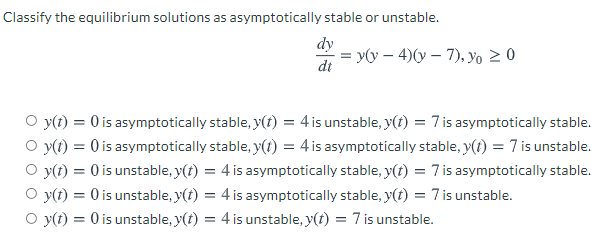Classify the equilibrium solutions as asymptotically stable or unstable. dy = y(y – 4)(y – 7), yo 2 0 dt O y(t) = 0 is asymptotically stable, y(t) = 4 is unstable, y(t) = 7 is asymptotically stable. y(t) = 0 is asymptotically stable, y(1) = 4 is asymptotically stable, y(1) = 7 is unstable. y(t) = 0 is unstable, y(t) = 4 is asymptotically stable, y(t) = 7 is asymptotically stable. y(t) = 0 is unstable, y(t) = 4 is asymptotically stable, y(t) = 7 is unstable. O y(t) = 0 is unstable, y(t) = 4 is unstable, y(t) = 7 is unstable.
Classify the equilibrium solutions as asymptotically stable or unstable. dy = y(y – 4)(y – 7), yo 2 0 dt O y(t) = 0 is asymptotically stable, y(t) = 4 is unstable, y(t) = 7 is asymptotically stable. y(t) = 0 is asymptotically stable, y(1) = 4 is asymptotically stable, y(1) = 7 is unstable. y(t) = 0 is unstable, y(t) = 4 is asymptotically stable, y(t) = 7 is asymptotically stable. y(t) = 0 is unstable, y(t) = 4 is asymptotically stable, y(t) = 7 is unstable. O y(t) = 0 is unstable, y(t) = 4 is unstable, y(t) = 7 is unstable.
Advanced Engineering Mathematics
10th Edition
ISBN:9780470458365
Author:Erwin Kreyszig
Publisher:Erwin Kreyszig
Chapter2: Second-order Linear Odes
Section: Chapter Questions
Problem 1RQ
Related questions
Topic Video
Question
100%
Please solve & show steps...

Transcribed Image Text:Classify the equilibrium solutions as asymptotically stable or unstable.
dy
= y(y – 4)(y – 7), yo > 0
dt
O y(t) = 0 is asymptotically stable, y(t) = 4 is unstable, y(t) = 7 is asymptotically stable.
O y(1) = 0 is asymptotically stable, y(1) = 4 is asymptotically stable, y(1) = 7 is unstable.
O y(t) = 0 is unstable, y(t) = 4 is asymptotically stable, y(t) = 7 is asymptotically stable.
O y(t) = 0 is unstable, y(t) = 4 is asymptotically stable, y(t) = 7 is unstable.
O y(t) = 0 is unstable, y(t) = 4 is unstable, y(t) = 7 is unstable.
Expert Solution
This question has been solved!
Explore an expertly crafted, step-by-step solution for a thorough understanding of key concepts.
Step by step
Solved in 3 steps with 5 images

Knowledge Booster
Learn more about
Need a deep-dive on the concept behind this application? Look no further. Learn more about this topic, advanced-math and related others by exploring similar questions and additional content below.Recommended textbooks for you

Advanced Engineering Mathematics
Advanced Math
ISBN:
9780470458365
Author:
Erwin Kreyszig
Publisher:
Wiley, John & Sons, Incorporated

Numerical Methods for Engineers
Advanced Math
ISBN:
9780073397924
Author:
Steven C. Chapra Dr., Raymond P. Canale
Publisher:
McGraw-Hill Education

Introductory Mathematics for Engineering Applicat…
Advanced Math
ISBN:
9781118141809
Author:
Nathan Klingbeil
Publisher:
WILEY

Advanced Engineering Mathematics
Advanced Math
ISBN:
9780470458365
Author:
Erwin Kreyszig
Publisher:
Wiley, John & Sons, Incorporated

Numerical Methods for Engineers
Advanced Math
ISBN:
9780073397924
Author:
Steven C. Chapra Dr., Raymond P. Canale
Publisher:
McGraw-Hill Education

Introductory Mathematics for Engineering Applicat…
Advanced Math
ISBN:
9781118141809
Author:
Nathan Klingbeil
Publisher:
WILEY

Mathematics For Machine Technology
Advanced Math
ISBN:
9781337798310
Author:
Peterson, John.
Publisher:
Cengage Learning,

